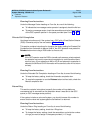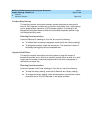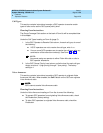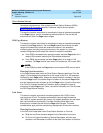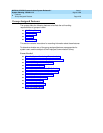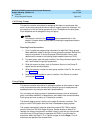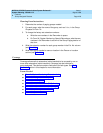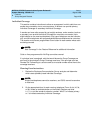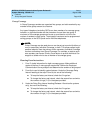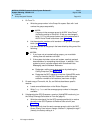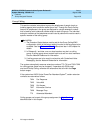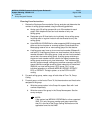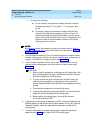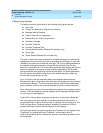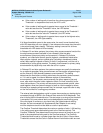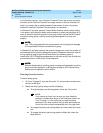
MERLIN LEGENDCommunications System Release 6.1
System Planning
555-661-112
Issue 1
August 1998
Features
Page 4-30Group-Assigned Features
4
Group Coverage 4
In Group Coverage, senders are organized into groups, and calls received by any
member of the group are sent to a receiver.
Any type of telephone (excluding QCCs) can be a member of a coverage group;
however, no individual sender can be a member of more than one group. A
maximum of 32 coverage groups can be set up, and there is no limit to the
number of senders in each group. Three types of receivers can be programmed:
calling groups, or the QCC queue and/or multiline telephones.
NOTE:NOTE:NOTE:
Group Coverage can be used alone or can be set up to work with either pri-
mary or secondary Individual Coverage, or both. This allows callers to get
personal attention from the primary and/or secondary Individual Coverage
receiver and backup from Group Coverage. For example, a receiver such
as a secretary can have a Primary Cover button to provide Individual Cov-
erage for a sender who is also a member of a coverage group.
Planning Form Instructions 4
1. Form 7c holds information for eight coverage groups. Make additional
copies of the form if more groups are planned. Review the Employee
Communication Survey analysis and determine the senders to be grouped.
2. Form 8a is used to identify system features. Under the Coverage Delay
Interval heading at the top of Form 8a, do
one
of the following:
■ To keep the factory-set interval, check the 3 rings box.
■ To change the factory-set interval, check the second box and write
the number of rings (1–9) in the space provided.
3. Under the Delay Ring Interval heading (Release 4.0 and earlier systems
only), do
one
of the following:
■ To keep the factory-set interval, check the 2 rings box.
■ To change the factory-set interval, check the second box and write
the number of rings (1–6) in the space provided.



